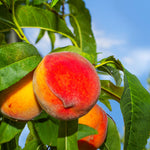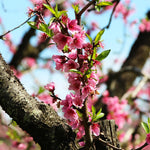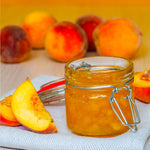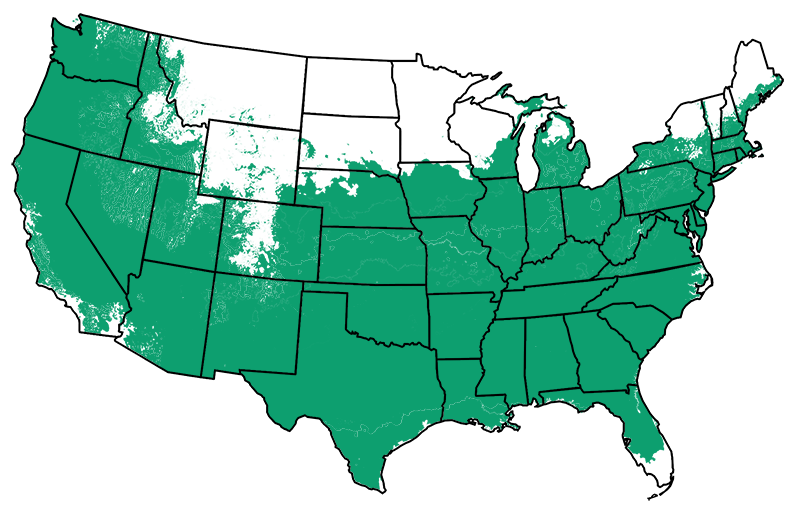Frost Proof Peach Tree Prunus persica Frost

The Frost Peach tree is great for colder regions.



* Images shown are of mature plants
Frost Proof Peach Tree Prunus persica Frost
Product Description
Huge Harvest of Ultra-Sweet Peaches in July and August!
Renowned for its extremely heavy fruit set, Frost Peach trees (Prunus persica 'Frost') also bear some of the sweetest peaches you'll ever eat! Why buy peaches when you can grow them in your own backyard? The freshness and taste of homegrown peaches are head and shoulders above supermarket fruit. Other than its characteristic trait of producing heavy crops of peaches, Frost Peach is also set apart from other peach trees by its disease resistance, early bloom, and early harvest.
Blush Blooms in the Spring!
Even before the beautiful fruit begins to form on Frost Peach trees, you'll be treated to a glorious springtime display of flowers. If you've never seen a peach tree in full bloom, you've missed out on a truly breathtaking sight. Peach blossoms bring a flurry of pink color to your landscape when summer flowers are still sleeping!
You Will Get Peaches Earlier than Other Peach Trees!
Frost Peach gives you an earlier harvest than other peach trees; as a comparison, it ripens two weeks earlier than Elberta. The tree is able to produce earlier harvests in summer because it blooms earlier in spring. Its early blossom time may leave it vulnerable to late-spring frosts in colder regions, but in warmer climates an earlier-blooming peach tree is welcome with open arms! Even in warmer climates, an unseasonably late-spring frost can injure the buds or blossoms, so you'll want to protect your tree if freezing temperatures are expected during bloom time.
Recommended as a Disease-Resistant Tree
Peach trees are notoriously susceptible to a fungal disease called peach leaf curl, which Washington State University notes as the most damaging peach disease in many regions. Although no type of peach tree is immune to this disease, Frost Peach is resistant to peach leaf curl, and it has the recommendation of Washington State University as a resistant tree.
Peach Trees in Landscape Design
The reason you'll order a Frost Peach tree is obviously because of the fruit it produces. But have you considered the double benefit it will bring you '– because of the ornamental value of its spring flowers? Peach blossoms are some of the prettiest early-season flowers you can grow, plus they're elevated on trees to give maximum impact to your landscape. Plant a grouping of Frost Peach trees in one section of your yard, or plant an entire row of trees for a brilliant show of spring color!
The Self-Fruitful Benefit
In the horticultural world of fruiting plants, "self-fruitful" is a desirable trait. It describes the ability of certain plants to produce fruit without the help of an additional plant to cross-pollinate their flowers. Your yard may not be large enough for two fruiting trees, and that's where Frost Peach comes to the rescue. It's a self-fruitful plant, so you only have to plant one tree to bear fruit!
Tip: Although you only need one Frost Peach tree to harvest fruit, when you plant one or more different types of peach trees, the result is a heavier fruit crop per tree because of the cross-pollination benefit.
Unlike Most Peaches, Frost Proof has Easy to Remove Seeds!
The large seeds inside peaches are also called "pits" or "stones," giving peaches the classification as "stone fruits." Some stone fruits require quite a bit of work to remove the pit from the fruit's flesh. Those types of stone fruits are called "clingstone" because of the way the seeds cling tightly to the flesh. But you won't have to struggle with Frost Peaches '– they are "freestone" fruits '– their seeds freely fall from the flesh to make pitting them much quicker and easier!
Winter Chilling Time
Many fruit trees, including peaches, must have a certain number of hours of cold weather each year '– when the temperatures are below 45 degrees F '– before they can set fruit. This is called a tree's "chill hours." Frost Peach trees grow as perennials in USDA Plant Hardiness Zones 5 through 9, but they must also meet a 700 chill-hour requirement to set fruit successfully. Most folks have no idea what the average chill hours are in their climate, but local Cooperative Extension Services have the answer. Simply give them a call to find out!
Pruned and Ready to Go
The correct pruning of peach trees benefits tree health and productivity. It's important to keep the trees open in the center to allow air to circulate freely and to enable sunlight to reach the branches. We've already done the technical work of pruning your Frost Peach to the perfect shape it needs to have. In future years, it should take you less than 30 minutes to shape each tree with this 2-step process:
1. Remove any sprouts from around the base of your tree.
2. Prune the tree so that three or four strong branches '– spaced widely '– arise from the trunk.
Don't begin pruning until the second growing season, and prune your tree in late winter while it's still dormant (no visible growth).
When to Harvest the Fruit
As Frost Peaches begin to grow, the fruits are golden-yellow. But as they mature, they become colored with a beautiful red blush across the yellow background. When the fruits are still somewhat firm, and the red blush has spread over the peaches, it's time to start picking! Peaches will continue to ripen off the tree, but only in texture and juiciness '– the flavor and sweetness won't increase. So experiment a little to find that perfect stage to pick the fruit.
Thinning the Fruit
Frost Peach trees set so much fruit that they benefit from a process called "thinning." Thinning removes excess fruit that can deplete nutrition from the tree, cause limbs to break, or prevent a tree from bearing a lot of fruit the following year. Some newly forming fruits will naturally fall from the tree in a self-thinning process, but you'll need to thin the ones that are left. Although you may not want to remove any of the small peaches from your tree, this practice really does help keep a tree healthier, and the fruits you leave will develop into larger peaches. About 4 to 6 weeks after the flowers have faded and tiny peaches have formed on the branches, thin the fruit to leave a spacing of 4 to 6 inches between peaches.
You'll Have Plenty to Freeze
What's better during the cold winter '– when your fresh peach harvest from the season before is long past '– than walking to your freezer and pulling out a container of frozen peaches? You can enjoy a wintertime peach cobbler with the Frost Peaches you grew the previous summer as you're sitting by a roaring fire! Set aside some fresh peaches during your harvest time for freezing. All you have to do is remove the pits; slice, dice, or puree them; and add 1/8 teaspoon of ascorbic acid to each quart of fruit. The ascorbic acid, which you can find at your supermarket, helps peaches keep their golden color. Pack the fruit into zippered freezer bags or plastic freezer containers. And then dream of that wintertime peach cobbler by the fire!
A Few Growing Tips
The first two years after you plant your Frost Peach tree are important factors in its long-term health and productivity. Before you even plant your tree, make sure it's on a site that receives full sun. Another must-have is well-draining soil. Peach trees need lots of water during their active growing season from April through September. Their peak demand for water is in July and August, which is the hottest time of year. So make sure that they receive at least 1 inch of water per week. If rainfall isn't enough, use your garden hose or a drip-irrigation system to keep the root systems hydrated. Have the soil tested every three to five years and fertilize your tree according to the soil-test recommendations.
Pollination Info
Frost Proof Peach Tree Pollination
Frost Proof Peach Trees are self-fertile. You will get fruit with only one plant. However, adding an additional Frost Proof Peach Tree will drastically increase the size of your crop.
Shipping Details
Estimated Shipping Time: Most orders ship within 1-2 days. As noted on the website, some items are seasonal, and may only ship in spring or fall. Once your order is shipped, you'll receive an email with a tracking number.
| Order Total | Shipping Charges |
|---|---|
| Less than $100 | $24.95 |
| $100.00-$128.99 | $29.95 |
| $129 + | FREE SHIPPING! |
Product Details
Growing Zones: 5-9 outdoors
 5-9 outdoors
(hardy down to -10℉)
5-9 outdoors
(hardy down to -10℉)
- Mature Height: 15-25 ft.
- Mature Width: 15-25 ft.
- Sunlight: Full Sun
- Spacing: 15-20 ft.
- Growth Rate: Fast Growing
- Does Not Ship To: AK, AL, AR, AZ, CA, CO, HI, ID, LA, MS, OR, WA
Customer Reviews & Photos




